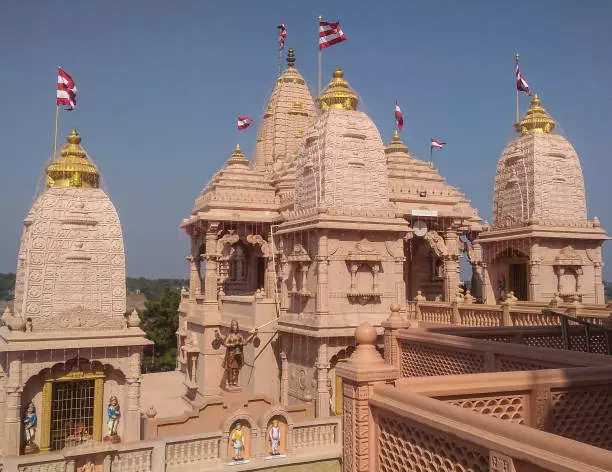‘Golden Touch’ to the Ram Temple at Ayodhya, Construction Enters its Final Stage
The Ram Temple at Ayodhya whose construction was started in 2020 is fast nearing completion with the ground floor of the temple expected to be completed by October this year and the temple will be formally inaugurated in January next year. Let us take a look at this beautiful structure and find out what all has gone in its making.

Updated Jun 13, 2023 | 12:05 PM IST

Ram Temple Ayodhya nears completion, find out more about its inauguration
Photo : iStock
The Ram Temple at Ayodhya is fast nearing its completion as construction enters its final stages. The ground floor of the temple is expected to be completed by October around Diwali and the temple will be consecrated next January -- at the beginning of the election year.
One of the unique things about the temple is the use of gold to decorate the door of sanctum sanctorum of the temple, giving it the ‘golden touch’.
Union home minister Amit Shah had promised last year that the temple will be ready for opening by January 1, 2024.
The temple will be a milestone for the ruling BJP, which considers the temple movement the fulcrum which led to its emergence as a national electoral force in the 1990s.
After the Supreme Court ended decades of legal wrangle with a milestone verdict in 2019 that went in favour of a temple, construction at the site started in August 2020.
The progress of the work which is monitored on a daily basis by the temple trust, was recently reviewed by the senior members of the Trust, including Nripendra Misra, Chairman, Construction Committee; the Engineering teams of Larsen & Tourbo, Tata Consulting Engineers and Ram Janmbhoomi Teerth Kshetra Trust members.
After the completion of the temple foundation, raft and plinth, the placement of Bansi Paharpur Rajasthan stone on the three-storey temple is going on in full swing in the run up to its inauguration in January next year.
Apart from Garbh Grah (sanctum sanctorum), the temple has five Mandaps, namely, Gudh Mandap, Rang Mandap, Nritya Mandap, Prathana Mandap and Kirtan Mandap. The domes of the five mandaps are 34 feet wide and 32 feet long and their height from the courtyard ranges from 69 feet to 111 feet.
The temple is 380 feet in length, 250 feet in width and 161 feet high from the courtyard. The three-storey temple has five mandaps and one main shikar. The size of the sanctum sanctorum is 20 feet x 20 feet in length and width, with a total area of 403.34 sq. ft. There will be 46 teakwood doors.
Around four lakh cubic feet of stone and marble from Rajasthan will be used for the structure, which will tower 161 feet over the sanctum sanctorum -- there will be no use of steel or bricks.
The entire sanctum sanctorum has been aesthetically carved using Makrana marble pillars, beams, ceiling and wall cladding. There are a total of 392 pillars which have been structurally provided taking into consideration the load factor and other climatic challenges.
To provide strength, longevity and durability to the structure, the construction material has been picked after vigorous analysis and careful scrutiny, which includes 1.30 lakh cubic meter of engineering fill in the foundation, 9500 cubic meter M-35 grade compacted concrete in raft, 6.16 lakh cubic feet of granite in plinth, 4.74 lakh cubic feet of Bansi-Paharpur stone in super structure of temple, 14,132 CFT carved Makrana marble stone in pillars and wall cladding and 76,219 square feet high quality Makrana marble flooring.
The temple will have both internal and external lighting arrangements with an in-ground uplighter, cove lighting, spot lighting and flexible linear lighting for ghumat level. The external view of the temple will have projected façade lighting.
The total area of the temple, including the peripheral Parkota, is 8.64 acres. The Parkota is 762 meter long with provision for six temples and facility for ‘Parikrama’ by devotees.
Once completed it is expected that the ancient ‘Kuber Tila’ with Shiva temple and proposed ‘Jatayu’ within the temple will also attract devotees in huge numbers.
The temple complex will also include a pilgrim facilitation centre, museum, archives, research centre, auditorium, cattle shed, a place for rituals, an administrative building and rooms for priests.
The date for the consecration has not been finalised yet, but it is likely to take place after Makar Sankranti.
Prime Minister Narendra Modi – who laid the foundation stone on August 5, 2020 -- will be present for the ceremony.
End of Article
Videos





07:41
IMD Briefing On Cyclone Biparjoy | Gujarat & Mumbai On High Alert | Landfall Expected In 24 Hours

04:31
OnePlus 11R, Samsung Galaxy A54, Vivo V27 Pro: Best Smartphones Under Rs 40,000 | Gadget Times

03:50
Realme 11 Pro | Unboxing & First Impression | Gadget Times

05:00
Apple Vision Pro | Here’s everything you need to know | Features, Price, Release Date & More

11:44
Apple's WWDC Event|| Everything You Need To Know | Gadget Times













